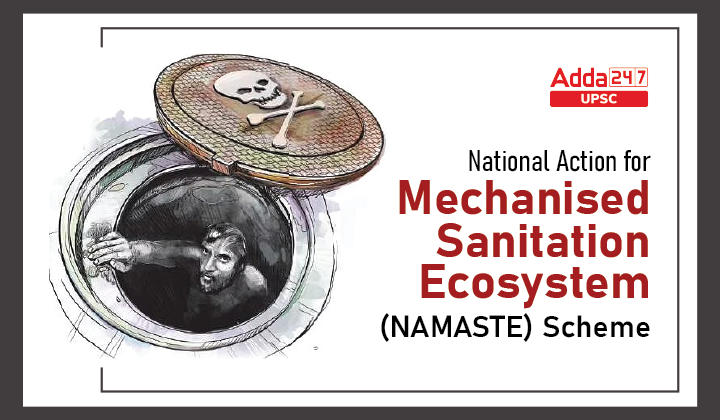Table of Contents
NAMASTE Scheme- Relevance for UPSC Exam
- GS Paper 2: Governance, Administration and Challenges- Welfare schemes for vulnerable sections of the population by the Centre and States and the performance of these schemes.
NAMASTE Scheme in News
- Recently, National Action for Mechanised Sanitation Ecosystem (NAMASTE) Scheme was launched by the Ministry of Social Justice and Empowerment (MoSJE).
NAMASTE Scheme
- About: NAMASTE envisages safety and dignity of sanitation workers in urban India by creating an enabling ecosystem that recognizes sanitation workers as one of the key contributors in operations and maintenance of sanitation infrastructure.
- Mandate: Ensuring safety and dignity of sanitation workers in urban India and providing sustainable livelihood and enhancing their occupational safety through capacity building and improved access to safety gear and machines.
- Parent Ministry: National Action for Mechanised Sanitation Ecosystem (NAMASTE) Scheme is a central sector scheme of the Ministry of Social Justice and Empowerment (MoSJE).
- It is being jointly implemented by MoSJE and the Ministry of Housing and Urban Affairs (MoHUA).
- Coverage: Five hundred cities (converging with AMRUT cities) will be taken up under this phase of NAMASTE. The category of cities that will be eligible are given below:
- All Cities and Towns with a population of over one lakh with notified Municipalities, including Cantonment Boards (Civilian areas),
- All Capital Cities/Towns of States/ Union Territories (UTs), not covered in 4(i),
- Ten Cities from hill states, islands and tourist destinations (not more than one from each State).
- Funding: The NAMASTE Scheme has been approved with an outlay of Rs. 360 crore for four years from 2022-23 to 2025-26.
Key Objectives of the NAMASTE Scheme
- NAMASTE would aim at-
- Providing access to alternative livelihoods support and entitlements to reduce the vulnerabilities of sanitation workers and
- Enable them to access self-employment and skilled wage employment opportunities and break the intergenerationality in sanitation work.
- In addition, NAMASTE would bring about a behavior change amongst citizens towards sanitation workers and enhance demand for safe sanitation services.
NAMASTE Scheme- Expected Outcomes
NAMASTE aims to achieve the following outcomes:
- Zero fatalities in sanitation work in India
- All sanitation work is performed by skilled workers
- No sanitation workers come in direct contact with human faecal matter
- Sanitation workers are collectivized into SHGs and are empowered to run sanitation enterprises
- All Sewer and Septic tank sanitation workers (SSWs) have access to alternative livelihoods
- Strengthened supervisory and monitoring systems at national, state and ULB levels to ensure enforcement and monitoring of safe sanitation work
- Increased awareness amongst sanitation services seekers (individuals and institutions) to seek services from registered and skilled sanitation workers
NAMASTE Scheme Implementation
- National NAMASTE Management Unit: National Safai Karamchari Financial Development Corporation(NSKFDC) would be implementing agency for NAMASTE.
- At the apex of the structure will be the National NAMASTE Monitoring Unit (NNMU) under Managing Director, NSKFDC, which will report to concerned Division head in the MoSJE, Government of India.
- Maximum monitoring and reporting will be on real time basis through mobile app and dedicated website.
- State Namaste Management Unit: The State Govt. will decide a suitable officer to be designated as State Namaste Director to head State Namaste Management Unit (SNMU).
- The officer may be from SBM, NULM, AMRUT or the ULB or any other relevant Department of the State.
- He will be assisted by PMU resource (State NAMASTE Manager) to be deployed under the Scheme as per requirement.
- At the City level, City NAMASTE Monitoring Unit (CNMU) shall consist of NAMASTE nodal officer of the city to be designated by the concerned ULB, who will be assisted by PMU resource (City NAMASTE Manager) deployed under the Scheme.
- City NAMASTE Monitoring Unit: PMU would be organised in clusters of municipalities to work as City NAMASTE Monitoring Unit (CNMU) so as to coincide with the SBM clusters.
- City NAMASTE Monitoring Unit (CNMU) would also ensure to cover any other urban body like sewerage board/jal board, cantonment board etc. dealing with sewerage operations in the city.
- IEC Campaign: Campaigns would be undertaken jointly by the ULBs & NSKFDC to spread awareness about the enumeration of target sanitation workers and other interventions of NAMASTE.
- Electronic and print media and hoardings at prominent locations shall be used for the campaign in local language and English/Hindi.
Swachh Survekshan 2023 launched under SBM (Urban) 2.0




 TSPSC Group 1 Question Paper 2024, Downl...
TSPSC Group 1 Question Paper 2024, Downl...
 TSPSC Group 1 Answer key 2024 Out, Downl...
TSPSC Group 1 Answer key 2024 Out, Downl...
 UPSC Prelims 2024 Question Paper, Downlo...
UPSC Prelims 2024 Question Paper, Downlo...




